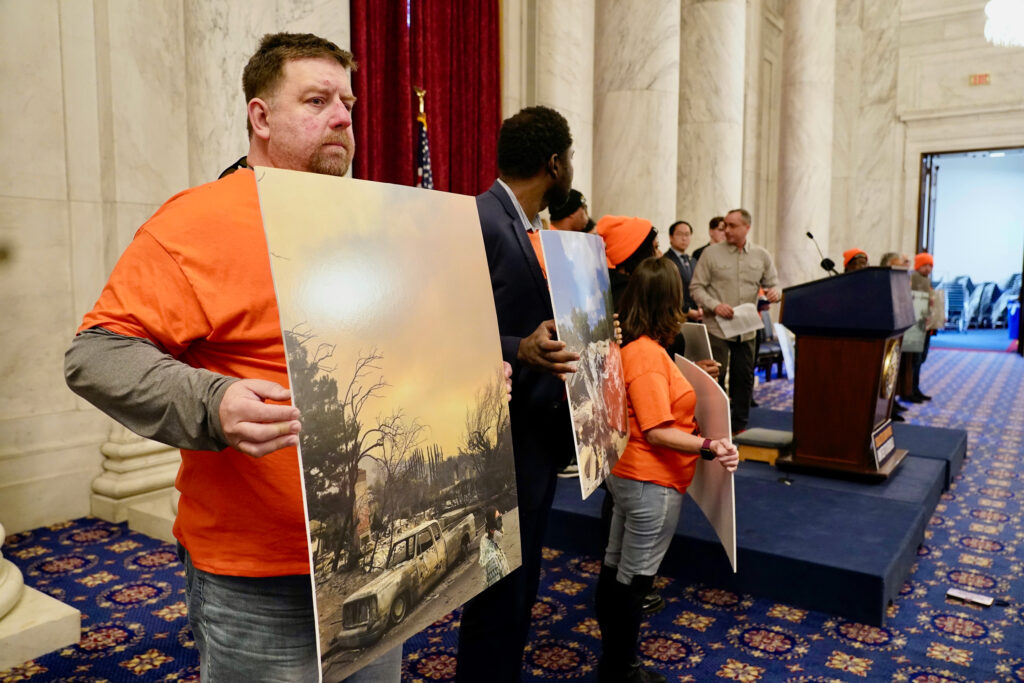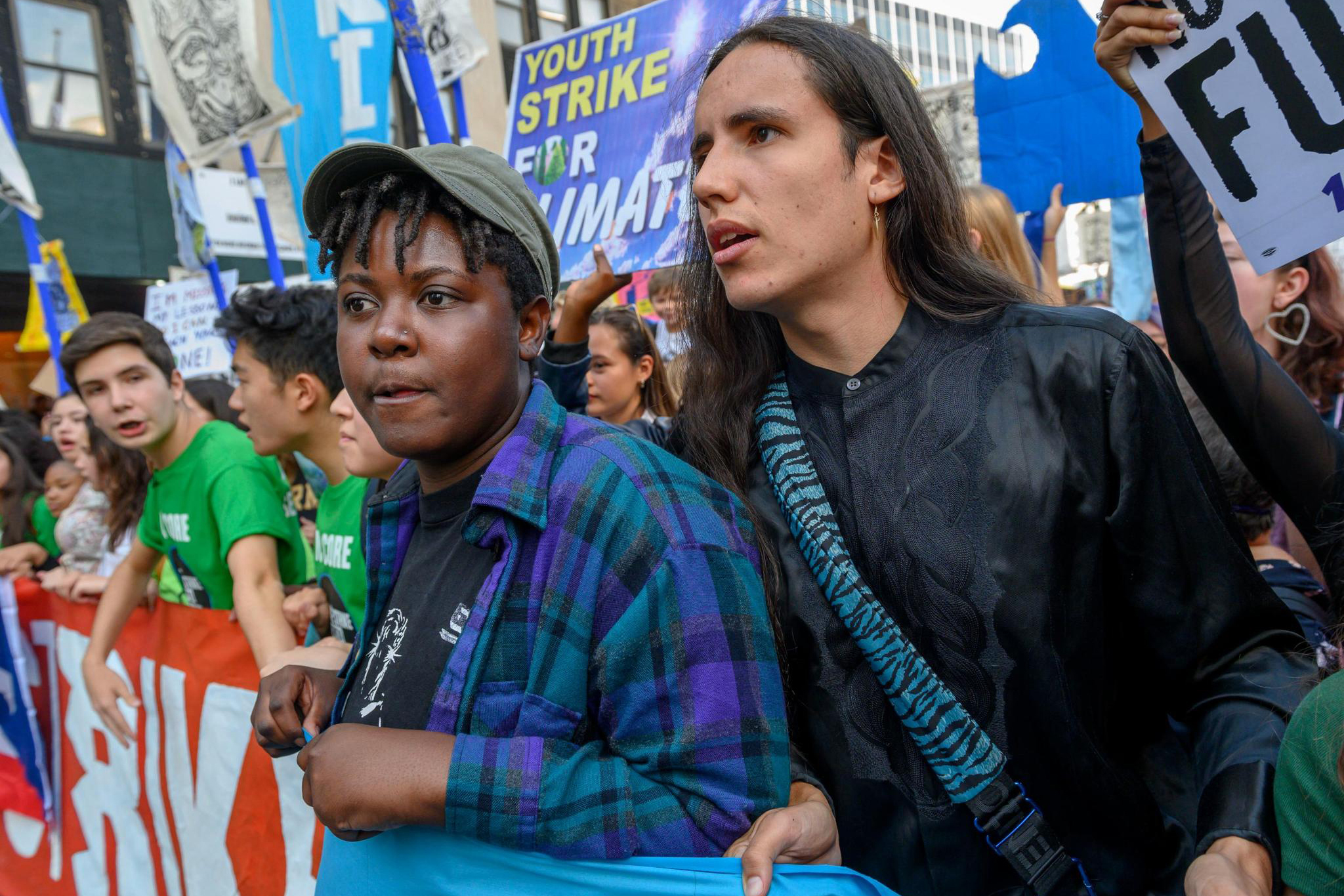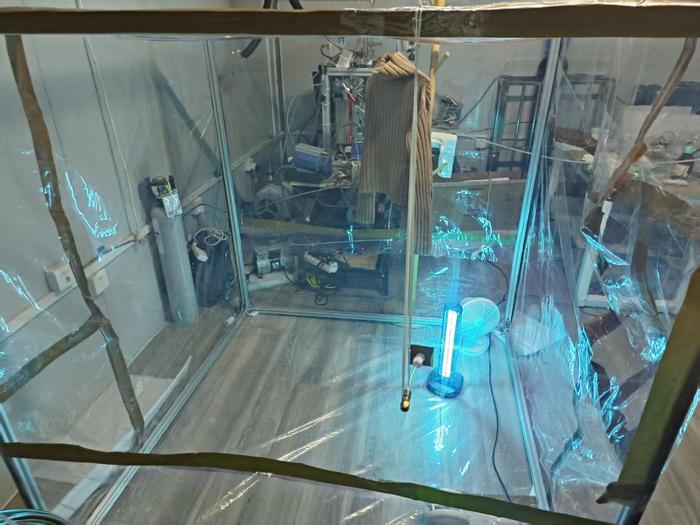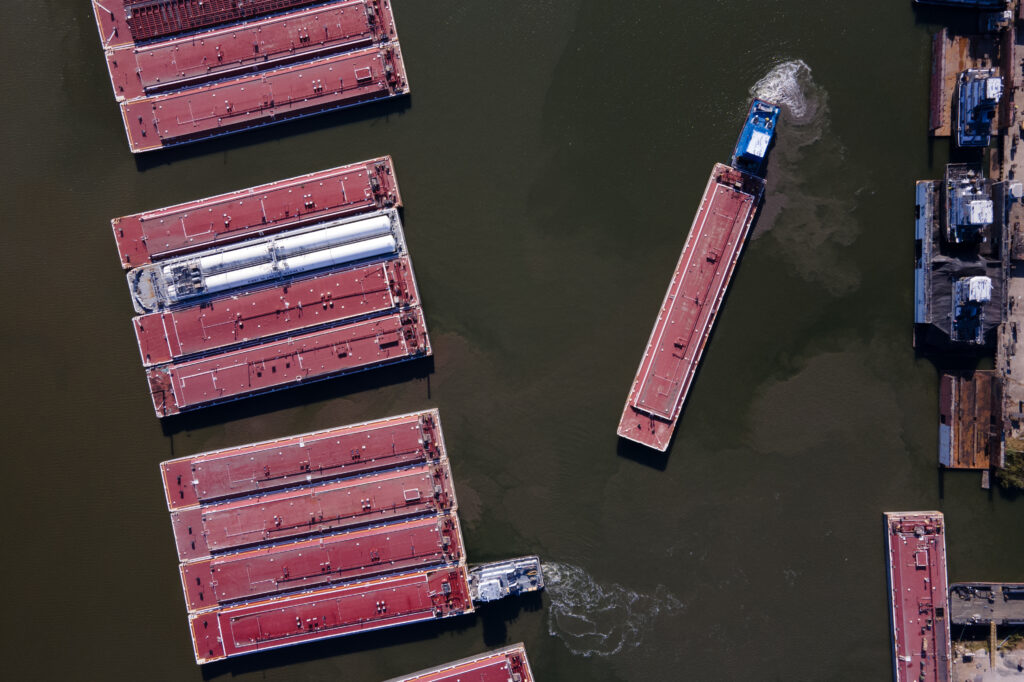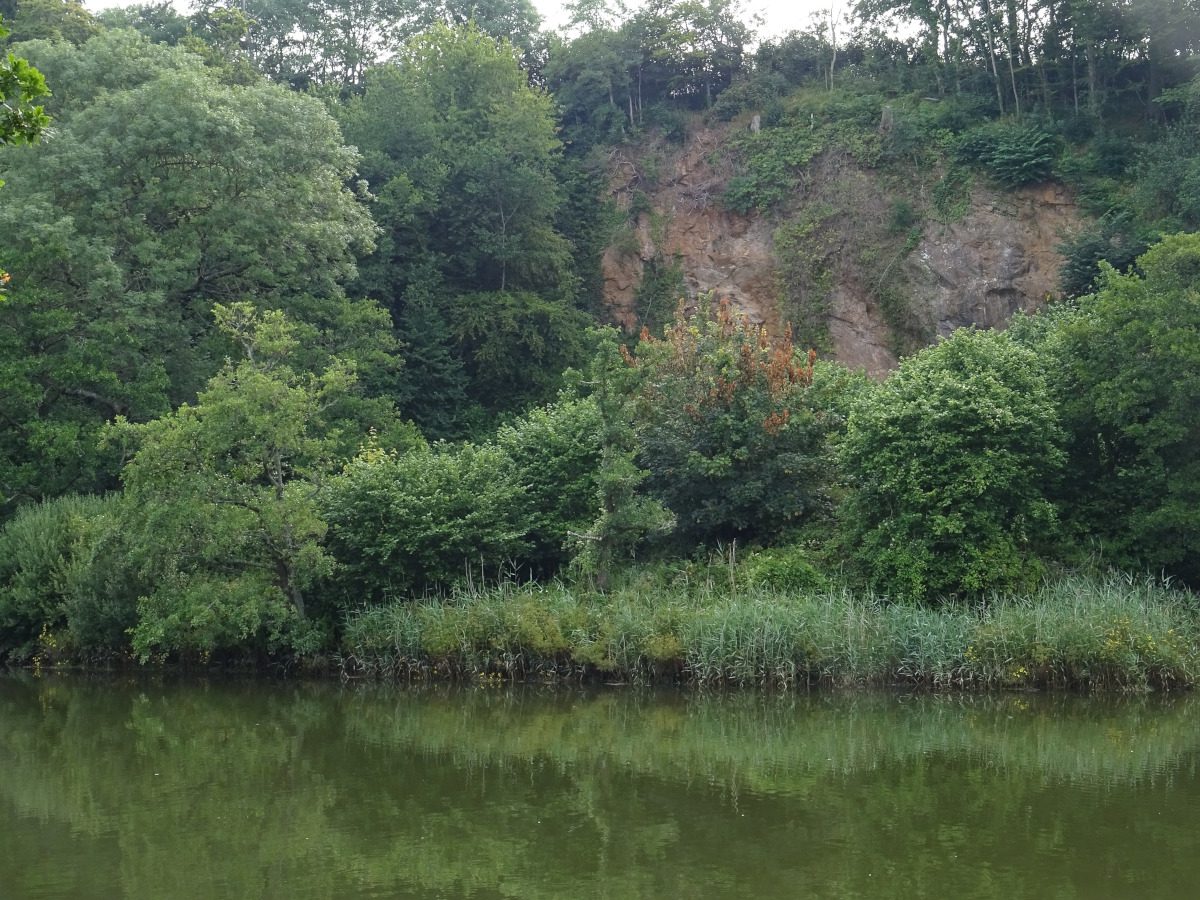As a 75-year-old asthmatic, Bernice Ramos was not supposed to be out walking in blistering heat, let alone going around her neighborhood to protest the windblown coal dust from the open-air export terminal in Curtis Bay that blankets everything, every day.
“I’ve been in this neighborhood for 22 years. And coal dust is everywhere. You’ve got to clean everything off before you can even sit down. I have asthma. And this affects me,” Ramos said, adding that she will be turning 76 this July.
Right then and there, a sudden bout of coughing left her reaching for her back pocket, fetching the inhaler, which she hastily put to her mouth—a familiar drill for asthma patients.
“I have to carry my inhaler with me 24/7, not knowing when I might need it,” she said, showing the bottle scribbled with the name of the issuing pharmacy and its contents.

Ramos was one of the many residents of the South Baltimore’s Curtis Bay neighborhood who came out on this hot and dry Monday afternoon in June for a rally organized by local community groups against government inaction to stem harmful pollutants and contaminants blowing into peoples’ homes, particularly from the open air coal piers operated by the multi-billion company CSX.
The 50-odd protesters, among them residents, community activists and advocates, made their way from the Curtis Bay Recreation Center to the CSX coal pier a couple of blocks away, amid the clamoring of protest chants, police sirens and flashing lights. A police chopper hovered overhead.
Undaunted by a glaring sun overhead and pollution from truck traffic, the protesters marched on, carrying placards and banners inscribed with demands for an end to coal operation in Curtis Bay. Some called on the Maryland Department of the Environment (MDE)—the state’s environmental regulator—to deny CSX’s operating permit or require stronger pollution controls.
We’re hiring!
Please take a look at the new openings in our newsroom.
See jobs
Workers from the National Lawyers Guild, a legal rights and watchdog group, documented police conduct from the sidelines as local law enforcers steered the procession through the neighborhood streets, diverting and halting traffic, mostly diesel-burning container trucks that routinely crisscross Curtis Bay thoroughfares, adding to particle pollution.
“We have coal dust in our pools, on our cars the day after we wash them. And we’ve tried contacting and telling CSX to do something about it. They say they’ll do something and nothing ever gets done,” said 23-year-old Thomas Vanskiver, who said the chorus of police activity and sloganeering made him realize what was going on and decide to join in.
“The coal dust problem has been there for as long as I can remember. My family’s been here since the 1970s and they’ve been complaining about it since then,” he said. “My aunt contracted lung cancer some time back and we don’t know if it was from the exposure to this pollution or something else. And there are so many other families in this neighborhood with similar stories to tell. We just don’t know what this is doing to us.”
A CSX spokesperson said that its coal pier operations adhere to strict regulatory standards. “We regularly invest in technologies and practices that go above and beyond those standards set by federal and state governments,” the statement said, adding that the company installed a fence line air monitoring system along the perimeter of the property as required by its air permit.
“Data from the fence line air monitoring is shared quarterly with the MDE and shows that the Curtis Bay facility is in compliance with the National Ambient Air Quality Standard (NAAQS) for PM2.5 and PM10,” the spokesperson said.
The CSX claims did not convince Nicole Fabricant, an anthropology professor from Towson University and environmental activist working in South Baltimore, who was among the organizers of the protest march.


She said scientists from Johns Hopkins University, along with students from its Bloomberg School of Public Health and South Baltimore residents, found the presence of PM 2.5, PM 10 and black carbon in and around Curtis Bay during a yearlong data collection effort using a hyper local air monitoring system.
Shorthand for particulate matter, PM 2.5 and 10 are extremely small particle pollutants suspended in air that can enter the respiratory system and lungs; exposure can increase the risk of heart disease, low birth weight and asthma. Sources of particle pollution can be indoor and outdoor.
Fabricant said that the analysis showed that fugitive coal from the coal piers was reaching as far as three-quarters of a mile throughout the community. A microscopic analysis of the collected coal dust, done separately in California, further proved that it was the actual coal from the coal pier.
Titled “Collaborative Investigation of Coal Dust, Air Pollution, and Health Concerns in Curtis Bay 2022–2023,” the study is a collaborative undertaking between South Baltimore-based community nonprofits, MDE’s Air and Radiation Administration, and Maryland’s top universities including the Johns Hopkins Bloomberg School of Public Health and the University of Maryland’s Department of Atmospheric and Oceanic Science.
The paper presents a sophisticated, data-driven forensic analysis of the fugitive coal dust escaping from the coal piers and is supplemented by residents’ testimonies and lived experiences. The study also acknowledges that the coal terminal was one of dozens of sources of air pollution in the area, including a medical waste incinerator, the WIN Waste trash incinerator, a landfill, oil and gas terminals and heavy diesel truck traffic.
Fabricant said one of the reasons for organizing the rally was to remind the MDE, which is close to issuing the new CSX operating permit, to include stringent pollution control requirements in the permit. “But we’re not very hopeful that MDE as a regulatory agency is going to really come down hard on CSX around emissions,” she said, adding that Maryland Gov. Wes Moore has yet to prove his commitment to environmental justice communities like Curtis Bay.
CSX’s current permit expired last September and the MDE has allowed the company to continue its operation under a temporarily extended permit until a final action on its permit renewal application is made.
“We are currently in a fact-finding phase of reviewing this operating permit application. The permit process was extended to allow for findings from the citizen-led air quality monitoring study to be included in the review,” said Jay Apperson, deputy director for the MDE’s office of communications. He said that the plan was to release a draft permit for public review in the spring. “That process was put on hold pending restoration of port operations after the collapse of the Francis Scott Key Bridge,” he added.
A spokesman for Moore said he defers to MDE’s comments on the issue and declined to comment on the activists’ assertion that Moore’s action trailed well behind his promises to address environmental injustices.
Meanwhile, marching to the beat of protest chants, the protesters arrived outside the CSX facility, secured by a chain link fence with coal pits towering in the background. Some in the group strung posters and banners to the fence that called on the company to cease operation, as police looked on and the surveillance chopper made rounds overhead.


For decades, South Baltimore communities have complained about risks to public health from the pollution-spewing industrial operation next to their neighborhoods, including the dark dust accumulating on their properties, which they blame on the CSX coal export operations running through South Baltimore neighborhoods via freight trains to and from the Port of Baltimore—the second-largest U.S. hub for coal exports.
The concentration of polluting industries produce a concoction of hazardous air pollutants regulated under the Clean Air Act, with potential health impacts ranging from asthma and cancer to premature death. These risks place Curtis Bay in the 99th percentile nationwide for elevated risk of explosions, leaks or spills due to close proximity to industrial facilities, the research study said.
Having hung the banner scribbled with words “Coal Kills” to the fence, the activists and residents then took to the microphone, reading their demands and describing their experiences out loud. They were particularly aghast at CSX’s refusal to accept the results of the citizen-led research, which found coal dust from the CSX-operated coal piers dispersed throughout the Curtis Bay neighborhood and included hazardous particle pollution, such as PM2.5.
“They’re trying to discredit the results we’ve compiled through our community science project.
We already know the issues in this community. The research has just confirmed what we’ve known for decades,” said David Jones, a resident-turned-activist. He said the community is tired of empty promises from city and state officials and it’s time for demonstrative action.
“Mayor [Brandon] Scott has been in office for four years and before that he was on the city council. But he seldom stepped foot in this community. We need him in his community. Otherwise there’s a political cost to be paid eventually for their inaction,” Jones said.
Greg Sawtell, an organizer with the Community of Curtis Bay Association, lamented that CSX continues to deny that its operation could potentially harm nearby communities.
“Now, when they’re facing the renewal of their permit, they’ve come out with their own research denying that there’s no problem of coal dust in the community,” Sawtell said.
This story is funded by readers like you.
Our nonprofit newsroom provides award-winning climate coverage free of charge and advertising. We rely on donations from readers like you to keep going. Please donate now to support our work.
Donate Now
Calling the collaborative research findings “incomplete and misleading,” the CSX statement said the experts it hired to “review the Collaborative Investigation found no evidence to support the conclusion that coal particles from the Terminal have a substantial impact on air quality in the Curtis Bay community.” It also asked the MDE not to base its permit renewal appraisals based on the community-led collaborative research.
The rally made its way back to the recreation center, winding through the neighborhood, calling on the city and state authorities to play their part in safeguarding public health from industrial facilities including the coal pier.
Ramos, who felt exhausted from walking and chanting slogans, stepped to the side to catch her breath. The wrinkles on her face were more pronounced from dryness. “I love being outside. But the pollution makes it hard. It’s affecting everybody—kids, elderly people like myself. Half of them don’t want to come outside.”
She said that her kids won’t come to see her for fear of exposure to coal dust. ”But here’s the problem. I love it here. And I love my neighborhood and my friends,” she said. “I’m not even supposed to be out here in this rally. What more can I do? But enough is enough. Mayor Scott, please do something. I want to be able to breathe.”








